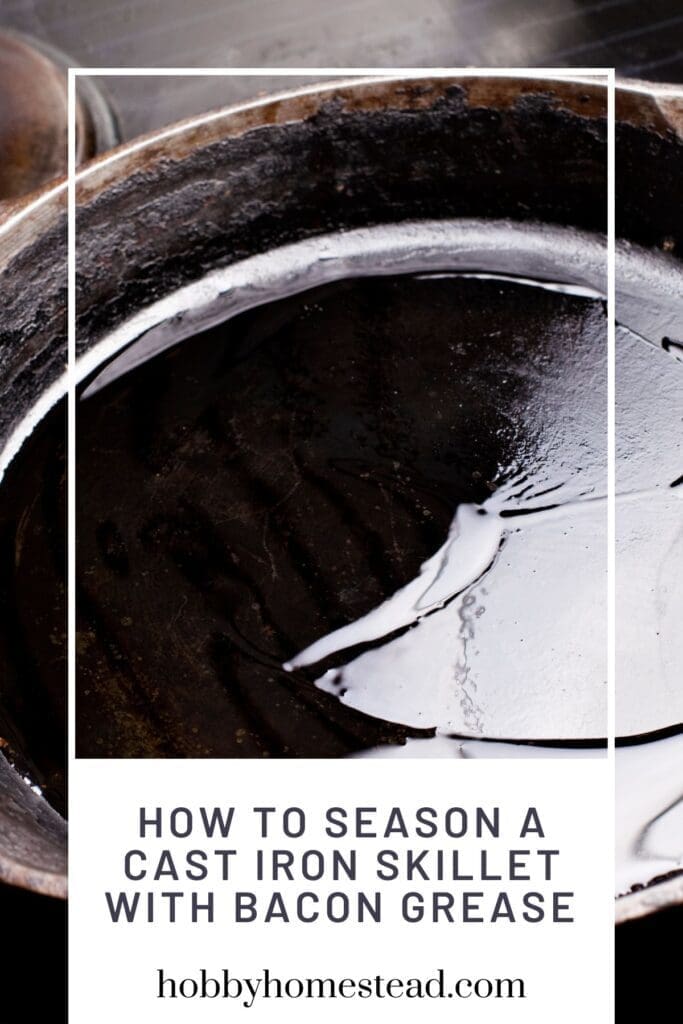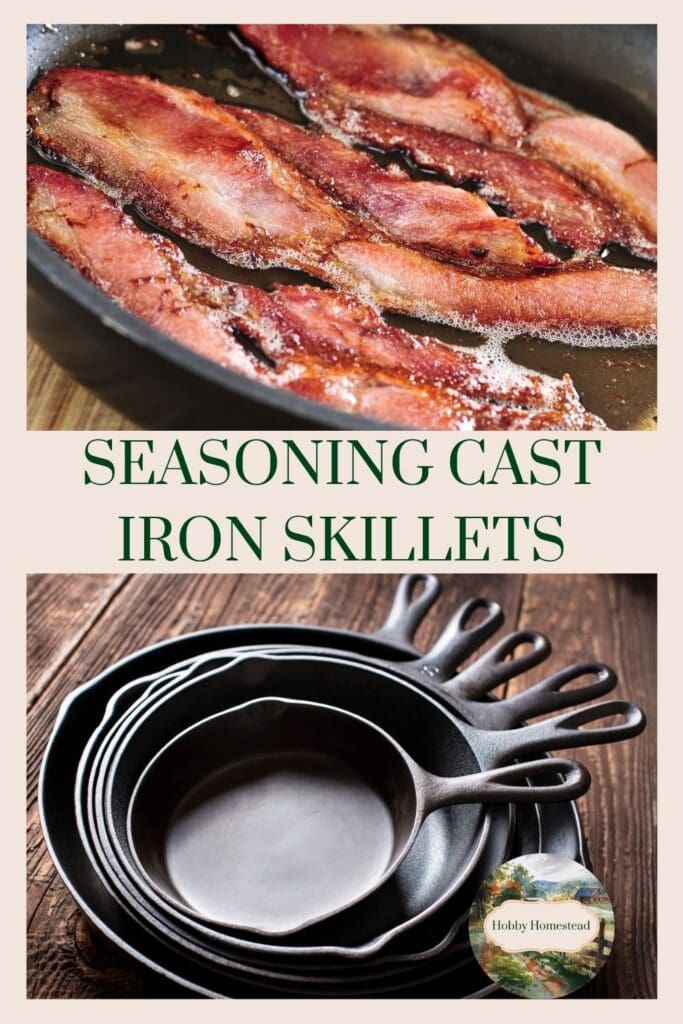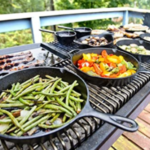Last updated on October 24th, 2024 at 02:24 pm
If you’ve ever wondered about the best way to season a cast iron skillet, you’re in the right place. Using bacon grease for the seasoning process not only gives your skillet a unique flavor but also ensures a well-seasoned cast iron pan.
Some people think a cast-iron skillet is hard to maintain. Actually, it’s as tough as nails. There are so many pans that have been around for decades. It’s built to last. While most new pans come pre-seasoned, you can season any cast-iron pan and bring it back to life.
Once a pan is seasoned properly, it becomes a nonstick skillet.
Whether you’re new to cast iron cookware or looking for ways to enhance your current skillet, this step-by-step guide will help you achieve a perfectly seasoned cooking surface.

Why Seasoning Your Cast Iron Skillet Is Important
Seasoning is essential for maintaining your cast iron cookware. It creates a protective layer of seasoning that prevents rust and ensures a non-stick cooking surface.
Proper care, including seasoning, extends the life of your skillet, making it a family favorite for a long time. Without this layer, your skillet may stick or become prone to rust, which is why a well-seasoned cast iron pan is the best investment for your kitchen.
Why Bacon Grease?
Using bacon grease for seasoning is a great way to utilize the natural fats from cooking bacon. Bacon fat is rich in flavor and helps create a durable seasoning layer on your cast iron skillet.
It’s a cost-effective choice that’s readily available after cooking a batch of bacon. Bacon grease, combined with its high heat properties, makes it a perfect candidate for seasoning your skillet, giving it a unique touch and a natural non-stick surface.

How to Season Your Cast Iron Skillet with Bacon Grease
- Preparation
- Gather Supplies: Start by gathering your cast iron skillet, clean cloths, bacon grease, and a baking sheet. If you’re seasoning a new cast iron skillet, ensure it’s free of any factory residue.
- Clean the Skillet: Before you begin, wash your skillet with warm water and a stiff brush to remove any dust or debris from manufacturing. Avoid using dish soap or harsh detergents, as they can strip the initial seasoning layer. Dry the skillet completely with a clean cloth.
- Season Cast Iron: Apply the Bacon Grease
- Melt the Grease: If your bacon grease is solidified, melt it in a small saucepan over low heat until it becomes liquid. This will make it easier to apply a thin layer of bacon grease to the skillet.
- Apply Evenly: Using a clean cloth or paper towel, apply a thin coat of bacon grease to the entire pan. Ensure that the grease covers the entire cooking surface, including the sides and handle, to create a uniform layer of seasoning.
- Bake the Skillet
- Preheat the Oven: Set your oven to 375°F (190°C) or 400°F (204°C), depending on your preference for high heat or medium heat. Preheating helps to activate the seasoning process.
- Place the Skillet: Place your skillet upside down on a baking sheet lined with a layer of foil. This prevents any excess grease from dripping onto the oven’s heating element. The pan upside position helps to evenly distribute the seasoning layer and prevents pooling.
- Bake Time: Bake the skillet for approximately 1 hour. This time allows the bacon grease to polymerize, forming a solid layer of seasoning that will enhance the non-stick properties of your skillet.
- Cool and Repeat
- Cooling: After baking, let the skillet cool in the oven. This helps the seasoning layer to set properly. If you notice any sticky spots or excess grease, you can gently wipe them off with a clean cloth.
- Repeating the Process: For a more durable seasoning layer, you can repeat the process. Applying a thin layer of bacon grease and baking the skillet several times will build up a stronger, more resilient seasoning.
Tips for Maintaining Your Seasoned Skillet
- Cleaning: After each use, clean your skillet with warm water and a wire brush or a stiff brush. If you can avoid using dish soap or harsh detergents as they can damage the seasoning. For stubborn residue, use a small amount of kosher salt with a clean cloth. According to Serious Eats, you can use a small amount of dish soap and warm water. Once seasoned, the material is no longer actually an oil, the surfactants in dish soap should not affect it. Go ahead and soap it up and scrub it out.
- Storage: Store your skillet in a dry place to prevent moisture from causing rust. A light coating of neutral cooking oil, such as safflower oil or canola oil, can help maintain the seasoning layer.
How to Season a Cast Iron Skillet with Bacon Grease
As an Amazon Associate I earn from qualifying purchases.
Equipment
Materials
- Bacon Grease
- Or another kind of oil with a high smoke point
- Clean Cloth
Instructions
- Start by gathering your cast iron skillet, clean cloths, bacon grease, and a baking sheet. If you’re seasoning a new cast iron skillet, ensure it’s free of any factory residue.
- Before you begin, wash your skillet with warm water and a stiff brush to remove any dust or debris from manufacturing. Avoid using dish soap or harsh detergents, as they can strip the initial seasoning layer. Dry the skillet completely with a clean cloth.
- If your bacon grease is solidified, melt it in a small saucepan over low heat until it becomes liquid. This will make it easier to apply a thin layer of bacon grease to the skillet.
- Using a clean cloth or paper towel, apply a thin coat of bacon grease to the entire pan. Ensure that the grease covers the entire cooking surface, including the sides and handle, to create a uniform layer of seasoning.
- Set your oven to 375°F (190°C) or 400°F (204°C), depending on your preference for high heat or medium heat. Preheating helps to activate the seasoning process.
- Place your skillet upside down on a baking sheet lined with a layer of foil. This prevents any excess grease from dripping onto the oven's heating element. The pan upside position helps to evenly distribute the seasoning layer and prevents pooling.
- Bake the skillet for approximately 1 hour. This time allows the bacon grease to polymerize, forming a solid layer of seasoning that will enhance the non-stick properties of your skillet.
- After baking, let the skillet cool in the oven. This helps the seasoning layer to set properly. If you notice any sticky spots or excess grease, you can gently wipe them off with a clean cloth.
- For a more durable seasoning layer, you can repeat the process. Applying a thin layer of bacon grease and baking the skillet several times will build up a stronger, more resilient seasoning.
Troubleshooting Common Issues
- Sticky Residue: If you encounter sticky spots after seasoning, it may be due to excess grease. Wipe off the sticky areas with a clean cloth and try reseasoning with a thinner layer of bacon grease next time.
- Rust Spots: If rust appears, scrub the affected areas with steel wool or a wire brush, then clean and reseason the skillet as described above.
- Heating a Skillet: To really heat cast iron evenly, place it over a burner and let it preheat for at least 10 minutes. Rotate the pan a couple of times for even heating. Alternatively, you can use the oven to heat it up. Just place it in a hot oven for 20 to 30 minutes. Once hot, the pan is great for searing steaks. The cast iron has a very high volumetric heat capacity. Which means that once it’s hot, it will stay hot for a long time.
Seasoning your cast iron skillet with bacon grease is a fantastic way to achieve a well-seasoned cooking surface while adding a unique flavor. By following these simple steps, you’ll have a perfectly seasoned skillet ready for all your cooking needs.
The Durability of Cast-Iron Skillets
Unlike many modern non-stick pans, which wear out over time, cast-iron skillets are built to last. With proper care, your trusty cast-iron skillet can serve you for decades or even generations.
Why Cast Iron Lasts
Cast iron is incredibly resilient. It doesn’t warp or dent easily, and the more you use and maintain it, the better it gets. The seasoning on the skillet becomes stronger and more non-stick over time, allowing you to fry, bake, or sauté with little effort. Many people inherit cast-iron cookware from family members, and it’s not uncommon to find perfectly usable skillets at thrift stores that are decades old.
Longevity with Proper Care
As long as you care for it properly—cleaning with warm water, using a salt scrub for stuck-on food, and re-seasoning as needed—your cast-iron skillet can last a lifetime. Its longevity makes it a sustainable choice for home cooks looking to avoid the cycle of constantly replacing cheaper non-stick pans.
References
Cast Iron Cookware Basics





This printable card for instructions is a great option.